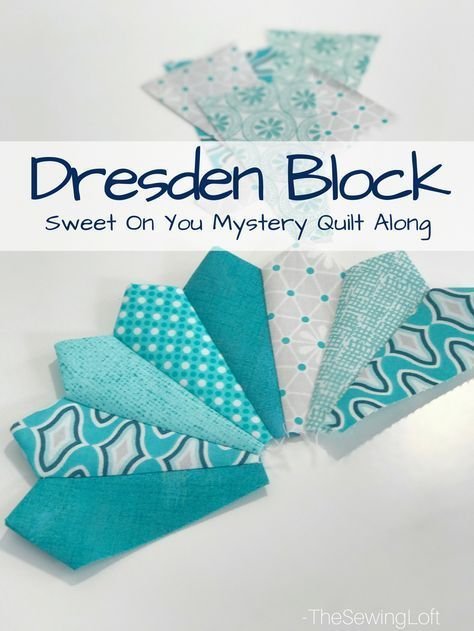The Dresden Block – Pattern is one of the most beloved and recognizable quilting patterns in the world of textile art. With its radiant, circular design reminiscent of vintage elegance, the Dresden block has remained a staple in traditional and modern quilting for decades. Whether you’re a seasoned quilter or just beginning your journey, the Dresden block offers creative flexibility and a unique opportunity to blend colors, textures, and fabrics into an eye-catching motif.
Originating in the early 20th century and named after the German city of Dresden, which was known for its ornate porcelain designs, the Dresden Block – Pattern showcases petal-like shapes arranged in a circular form, often surrounding a central appliqué circle. The versatility of this pattern makes it suitable for quilts, pillows, wall hangings, and other textile crafts. It allows quilters to play with a wide range of fabrics and showcase intricate piecing techniques, making each project a work of art.
In this article, we’ll explore how to create the Dresden block, its variations, design tips, and how to incorporate it into different quilting projects. From choosing fabrics to finishing touches, you’ll find everything you need to make your Dresden Block – Pattern creations stand out. Let’s dive into this timeless quilt block and uncover what makes it so special.

1. Understanding the Dresden Block – Pattern
The Dresden Block – Pattern consists of a circular arrangement of blades or petals that radiate from a center point. Each blade can be made from different fabrics, giving the block its signature dynamic look. Traditionally, the block contains 12 to 20 blades, but modern interpretations can vary widely in the number and shape of the blades used.
One of the reasons this pattern is so popular is its ability to highlight fabric collections. Quilters often use scraps or coordinated fabric bundles to create vibrant, multi-patterned blocks. Whether using bold solids or delicate florals, the pattern adapts beautifully.
The core of the Dresden block is the circle at the center, which hides the junction of the blades. This center circle can be appliquéd by hand or machine and can feature contrasting or matching fabrics to enhance the visual impact of the design.
There are also numerous blade variations: pointed tips, rounded tips, or even scalloped edges. These changes can dramatically alter the feel of the finished block. The pointed tip is the most classic look, while rounded tips offer a softer, more whimsical style.
The block is often sewn onto a background square, and this square can be used as a single block in a quilt or repeated in a grid for a full quilt top. Embellishments like embroidery, buttons, or decorative stitches are also popular additions.
Finally, it’s worth noting that the Dresden Block – Pattern is an excellent project for quilters looking to improve their piecing and appliqué skills. It offers a balance of precision and creative freedom that appeals to many.
2. How to Make a Dresden Block – Pattern
Creating a Dresden Block – Pattern begins with choosing or creating a template for the blades. Templates are typically made from cardboard or plastic and can be reused for multiple projects. Precision in cutting is essential for a balanced and symmetrical block.
Once the blades are cut, the next step is sewing the tips. If you’re making pointed blades, you’ll fold each blade in half lengthwise, sew across the top, turn it right-side out, and press it flat. For rounded tips, a curve is sewn and turned in a similar manner. This step is key for shaping the visual appeal of the block.
The blades are then sewn together along their long sides to create a complete circle. Many quilters use a ¼ inch seam allowance for accuracy and consistency. After all the blades are sewn into a full ring, it’s pressed flat to maintain the shape and eliminate puckering.
The next step involves attaching the circle to a background fabric. Centering the block on a square of fabric, it’s typically stitched down using a straight stitch or zigzag stitch. Fusible webbing can also be used to secure it before sewing.
Now, the center circle is added. This circle not only adds aesthetic charm but also hides the raw edges where the blades meet in the middle. It can be a solid fabric, a patterned one, or even a feature print to draw attention.
To finish the block, quilters may add quilting stitches through the blades and background. These stitches can be decorative or functional, helping to hold all the layers together if the block is going to be used in a full quilt.
3. Creative Variations of the Dresden Block – Pattern
The Dresden Block – Pattern is highly adaptable, making it a favorite for creative experimentation. By varying the number of blades, you can create different looks. For example, more blades result in a fuller, more detailed block, while fewer blades give a minimalist, modern vibe.
One variation is the “modern Dresden,” where asymmetrical blades or negative space are used. Some quilters intentionally offset the circle or use background fabrics in bold, solid colors to contrast with the detailed Dresden design.
Color placement plays a huge role in how the block is perceived. Using a gradient of colors can create a rainbow or ombré effect. Alternatively, alternating two colors in a symmetrical pattern creates a more structured, geometric look.
Layered Dresdens are another creative twist. In this variation, a smaller Dresden ring is appliquéd on top of a larger one, often with contrasting fabrics. This adds depth and complexity to the block.
Some crafters use fussy cutting—a technique where specific motifs from fabric are deliberately cut and placed—to create a striking center circle or even themed blades, such as florals, holiday prints, or novelty fabrics.
Another fun idea is to break away from traditional square blocks. You can appliqué the Dresden Block – Pattern onto circular or hexagonal backgrounds, or even combine several Dresdens to form a medallion centerpiece on a quilt.
4. Tips for Perfecting Your Dresden Block – Pattern
Achieving a clean, professional look with your Dresden Block – Pattern takes practice, but with the right tips, your results will shine. First, invest in a high-quality template or ruler specifically designed for Dresden blades. These tools save time and improve precision.
Use starch or a fabric stabilizer on your fabric before cutting the blades. This reduces fraying and helps maintain the blade shape during sewing. Pre-washing your fabric can also help prevent shrinking or color bleeding later on.
Take your time when aligning the blades. Nesting the seams and pressing each seam open or to the side can help create a flatter, smoother finish. This makes quilting over the block easier and improves the overall appearance.
When sewing the center circle, consider using freezer paper or a heat-resistant template to turn the edges neatly before appliquéing. This technique helps create a perfectly round and crisp circle.
Experiment with different background fabrics before committing. Sometimes a neutral or muted background makes the Dresden block pop, while in other designs, a bold or patterned background can add extra energy.
Lastly, remember that quilting is both art and craft. Don’t be afraid to personalize your Dresden Block – Pattern. Whether through color, texture, or embellishments, your block should reflect your unique creative voice.
Frequently Asked Questions (FAQ)
What is a Dresden Block – Pattern in quilting?
A Dresden Block – Pattern is a quilt block featuring a circular design made of wedge-shaped blades radiating from a central point. It’s typically appliquéd onto a square background with a center circle to complete the motif.
How many blades are in a traditional Dresden block?
Traditionally, a Dresden block has 12 to 20 blades, but quilters can adjust the number based on their template and design preference.
Can beginners make a Dresden block?
Yes! While it may look complex, the Dresden Block – Pattern is beginner-friendly with a bit of patience. Using templates and focusing on precise cutting and pressing helps simplify the process.
What fabrics are best for the Dresden Block – Pattern?
Cotton fabrics work best due to their stability and ease of handling. You can use solids, prints, or even scrap fabrics to create dynamic visual effects.
What size should a Dresden block be?
Block size can vary depending on the template and blade length. Common sizes range from 8” to 12”, but it’s highly customizable depending on your quilt design.
Can the Dresden block be made without a sewing machine?
Yes, it can be hand-stitched, although it takes more time. Many traditional quilts were made entirely by hand, including Dresden blocks.
Conclusion
The Dresden Block – Pattern is more than just a classic quilt block—it’s a canvas for artistic expression. With its blend of traditional roots and modern adaptability, this pattern continues to inspire quilters around the world. Whether you’re aiming for vintage charm or contemporary flair, the Dresden block offers endless design possibilities and the satisfaction of handcrafted beauty.
We hope this article gave you the tools and inspiration to start your own Dresden Block – Pattern project. If you’ve made one already or plan to, we’d love to hear your sincere opinion and any suggestions you may have. Your feedback helps us create even more helpful content for quilting enthusiasts like you!

